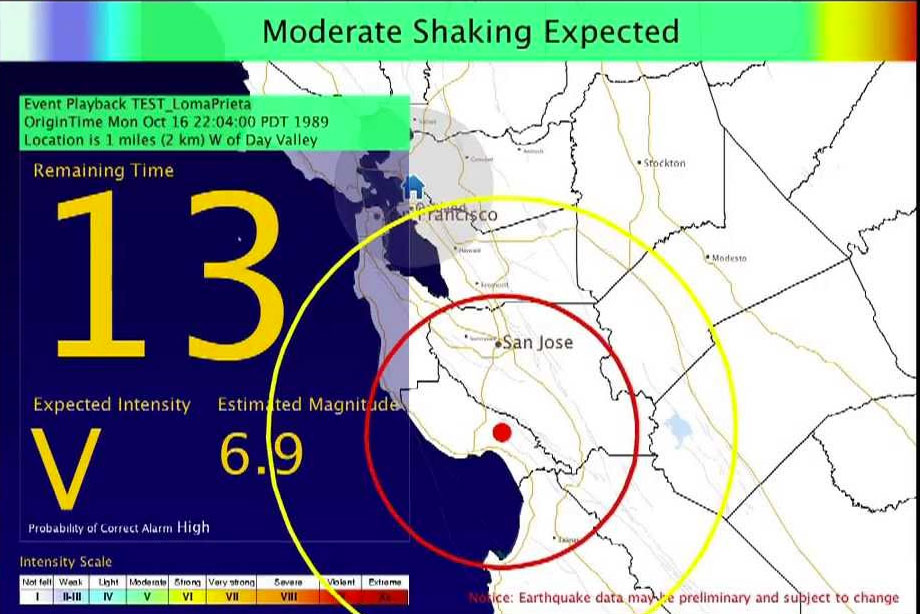State budgets $10 million for earthquake early warning
Gov. Brown's $171 billion budget includes build-out of ShakeAlert warning system

June 30, 2016
Gov. Jerry Brown has signed a 2016-17 state budget that provides $10 million to help launch a statewide earthquake early-warning system.
Although California passed a mandate in 2013 to create a statewide earthquake warning system, this is the first money appropriated by the state to make it a reality. The federal government has already provided $13.2 million to improve and test a prototype West Coast early-warning system, but this is much less than the $38 million in buildout costs and $16 million per year in operating costs needed to establish a fully functioning system serving California, Oregon and Washington.
“This is a key step toward the goal of a public earthquake early-warning system for the entire state,” said Richard Allen, director of the Berkeley Seismological Laboratory at UC Berkeley and one of the lead researchers on the project. “This funding will enable us to add more sensors to the seismic networks, making the warnings faster and enabling the system to reach more users.”
“This is an excellent beginning,” said state Sen. Jerry Hill, San Mateo and Santa Clara counties, who introduced funding legislation for the warning system earlier this year with Assemblyman Adam Gray, Merced, and state Sen. Robert Hertzberg, D-Van Nuys. “While we still have work to do to secure public-private partnership money to complete the build-out, this $10 million is a big boost.”
The $10 million is seed money from the Governor’s Office of Emergency Services. The funds will enable scientists and emergency preparedness experts from UC Berkeley, the U.S. Geological Survey and the California Institute of Technology to expand an early-warning prototype called ShakeAlert, which would provide advance warning of seconds to a minute before ground-shaking from a nearby earthquake. The funds will also be used for education, research, sustainable financing and other important project components.
Several pilot projects have been established around the state to beta-test ShakeAlert and the viability of the warning system, but ShakeAlert’s reach is limited by system distribution, strength and capabilities. Including station additions in the past year, ShakeAlert has just 538 sensors around the state and is available only to partners in the prototype project, such as the Bay Area Rapid Transit system. In contrast, the statewide earthquake early-warning system would need several thousand sensors throughout California to reliably notify the public.
 “While the ShakeAlert project partners have been able to add some additional stations, this funding will enhance the buildout of the seismic networks to provide the best possible warnings for Californians,” said Allen, a professor of earth and planetary science.
“While the ShakeAlert project partners have been able to add some additional stations, this funding will enhance the buildout of the seismic networks to provide the best possible warnings for Californians,” said Allen, a professor of earth and planetary science.
Hill, Hertzberg and Gray took on the bipartisan effort after being approached by Allen and his team through UC Berkeley’s Office of Government and Community Relations, whose staff also briefed the governor’s staff about the need for a system to protect lives and property throughout the state.
The original mandate, SB 135, was authored by then-state Sen. Alex Padilla and signed into law in 2013. Padilla’s intent was that the system would be funded by public-private partnerships, but it became apparent that public funding would be needed to supplement any such partnerships. Cal OES has since worked with partner organizations from the California Integrated Seismic Network, the private sector, utilities, the Legislature and all levels of government to implement the system.
California is second only to Alaska when it comes to earthquake activity in the country, according to the USGS. About $3.5 billion, or 66 percent, of the monetary losses suffered from earthquakes in the U.S. each year occur in California, the Federal Emergency Management Agency says.
Seismologists agree that California is due for another “Big One.” The Uniform California Earthquake Rupture Forecast in 2015 said there is a 99.7 percent likelihood that an earthquake with a magnitude 6.7 or greater will occur in California in the next 30 years – and a 93 percent chance that an earthquake with a 7.0 magnitude or greater will occur.
“Funding programs that keep our constituents safer should be a top priority for the Legislature and the administration,” said Gray. “The earthquake early-warning system will protect property, mitigate systemic damage and above all save lives in the event of an earthquake. The $10 million that we worked so hard to get approved in the budget will certainly provide a much-needed kick-start to the program, but there is still plenty of work to be done.”
“We know it is coming — it’s just a matter of time — and the sooner we get the early-warning system up and running, the better,” said U.S. Rep. Adam Schiff, who represents Pasadena and Caltech and has led funding efforts for the warning system and earthquake preparedness at the federal level. “I hope today’s investment by California will encourage Oregon and Washington state to join the effort so we can build out the system along the entire West Coast.”
RELATED INFORMATION
- White House renews commitment to earthquake early warning system designed at UC Berkeley (February 2016)
- Political leaders agree: The time for a statewide earthquake early warning system is now. (September 2014)
- Seismologists urge creation of earthquake early warning system along Pacific Coast (April 2011)